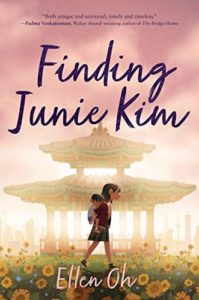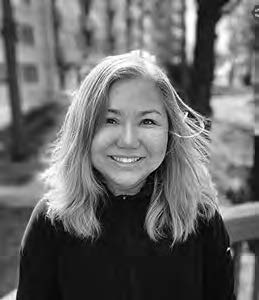 Finding Junie Kim
Finding Junie Kim
By Ellen Oh
New York: Harper Collins, 2021
384 pages, ISBN: 978-0062987990, Paperback
Winner 2021 Freeman Book Award for Young Adult/Middle School Literature
Reviewed by Charles Newell

How do you engage middle-grade students on issues of racism, political division, and immigration while also discussing the oft-overlooked Korean War and the importance of family connections? In her novel Finding Junie Kim, Ellen Oh attempts to do all these things. Oh has written other novels for middle-grade readers; she is best-known for two book series: The Dragon King Chronicles and The Spirit Hunters. These books fall into the horror or fantasy genre with young, multicultural protagonists battling mythological creatures or ghosts. However, her latest book, Finding Junie Kim, is very much rooted in the real world. One of the main storylines in the novel concerns Korean children surviving the Korean War and eventually immigrating to America as young adults. The reader learns at the end of the novel that the stories Oh recounts actually happened to Oh’s maternal grandparents. This concept is perfect for Oh’s audience since her grandparents were about middle school age when they survived these extraordinary events. Despite their youthful age, they deal with death, upheaval, and the maddening politics of the Korean War. They are certainly heroes that young readers can look up to.
But this book does not begin with their stories. Oh attempts to draw in her audience by setting the book in the early twenty-first century. Oh frames her account of the Korean War by discussing the struggles of her narrator, Junie Kim, as she begins seventh grade in current-day America. Oh’s intended audience will certainly identify with many of Junie’s problems: bullies, friend group drama, and strict parents who deny her a cell phone. But Oh then adds another layer to her modern problems: racism. As the school year begins, someone has plastered racist graffiti on the gym walls of Junie’s school. (Oh also reveals at the end of the book that this shocking event was based on actual racist graffiti that appeared in her own community.) This overt racism causes much concern among Junie’s multiracial friend group, and to heighten the drama, Oh questionably even brings in current presidential politics with mentions of red hats and racist/ anti-immigrant insults from bullies. While these are plausible scenarios that some students will recognize, this first section of this novel risks coming off as overdrawn and too melodramatic.
Oh appears to try too hard to interject as many conflicts for her narrator as possible. Our protagonist experiences almost every problem a middle-schooler can face. In addition to the bullying,
the racism, the divisive politics, the friend drama, and the busy parents who ignore her, Junie also suffers from depression and confronts her own suicidal thoughts, which eventually land her
in the hospital. Luckily, Junie does have a great support system, and once her parents realize her struggles, they get her the help she needs. However, it is the intervention of her grandparents that
really redeems Junie and her situation. In the middle part of the book, Junie first learns of their difficult lives back in Korea, and she begins to take pride in her cultural heritage and learns to face
her modern-day problems, which are nothing compared to the difficult lives of her grandparents.
Thus, it is this personal crisis and breakdown that leads Junie to discover her family’s history. For a school project, Junie must interview someone from an older generation, and she naturally
selects her grandparents. In contrast to the racism that Junie encounters at her school, she learns that racism in America was far worse when her grandmother and grandfather first immigrated as
college students in the 1960s. They felt like outsiders at school and in the workforce. They were even denied housing, despite having good white-collar jobs, simply because they were foreigners,
Asian, the “other.” Junie’s discussions and recorded interviews with her grandparents lead to the most compelling sections of the book: the stories each grandparent tells about how they survived
and kept their families together, despite their young ages and the trials of the Korean War. Junie learns about inner strength and the importance of family. Her grandparents were both about ten
years old when they had to assume adult roles because of the war. Through this interview process, we learn about the mindless violence each side committed against the other in the war and the incredible journey that Junie’s grandmother took to track down her separated family. Again, all this becomes more remarkable when we find out it is a true story.
It should be noted that this novel does not contain a full account or explanation of the Korean War. It is not a primer for this time in history. Yes, the book mentions how the country is divided into the Communist North and the American-backed South, but for the most part, the accounts of the war are very personal and focus only on the life experiences of Junie’s grandparents. The reader is given brief explanations of how the North Korean forces quickly overwhelmed the South, but all this sits at the periphery of two families trying to survive and stay together amidst a conflict they do not understand themselves. Missing in the novel is any discussion of the role of starkly contrasting ideologies in the conflict, which in the ensuing decades have rendered South Korea a free society
by world standards and North Korea one of the world’s most repressive regimes. The novel does a good job of showing the amorality of war. Both sides of the conflict commit questionable acts and damage the lives of ordinary people, all in the name of making sure one side wins over the other at any cost. Oh does miss an opportunity to further discuss this troubling aspect of military conflicts, but we are definitely shown the pointlessness of war at one level. Without a doubt, this book could be a good jumping-off point for discussing Cold War politics and the Korean conflict (or really any war for that matter).
As you consider this book for classroom use, it should be noted that Ellen Oh is a founding member of We Need Diverse Books, an organization founded in 2014 when a group of children’s authors decided there was not enough multicultural representation in the field of children’s literature. Oh and her colleagues established The Walter Dean Myers Award for Outstanding Children’s
Literature, known as “The Walters.” Since 2016, this organization has recognized books from underrepresented voices in the publishing industry. Like many of her fantasy novels, Finding Junie
Kim has a Korean protagonist, and overall, the book does a good job of introducing a culture that is not often represented in middle-grade books.
Still, this novel deals with many current social issues and may not be appropriate for every middle-grade reader. Some may want to avoid references to our current political divide. The book not
only mentions racist graffiti and people who wear red hats with slogans on them, it also discusses topics like Black Lives Matter and systemic racism, though only briefly. Also, as mentioned earlier, Junie deals with depression and suicidal thoughts, which might be too real for some readers. And it should be noted that the novel also describes war, torture, and death as related to the Korean conflict, though not graphically or to excess.
What makes this novel unique and a potentially a useful classroom resource is the presentation of Junie Kim’s cultural heritage. Oh certainly fulfills the mission of We Need Diverse Books, though it could be argued that she tries a bit too hard to interject every social and personal problem into Junie’s life. Still, Korean food is mentioned constantly. The reader will be intrigued by the mentions of the various meals and snacks eaten by Junie’s family. The book also contains a Korean glossary in the back for the various Korean terms used throughout the book. Some deal with the food, but most of these terms deal with relationships within a Korean family, which again is a great way to begin a discussion about cultural differences and why familial relationships and hierarchy are so important in Korean society. Oh’s novel would be a great independent read for someone who wants to see their culture represented in literature or for someone who wants to understand their Korean classmates better. Overall, this novel tells the story of a young person finding the inner strength to deal with the problems many young people face in our modern world. But more importantly, the book shows us that by listening to our parents and grandparents, and developing a good relationship with them, we could learn much about overcoming obstacles in life.

